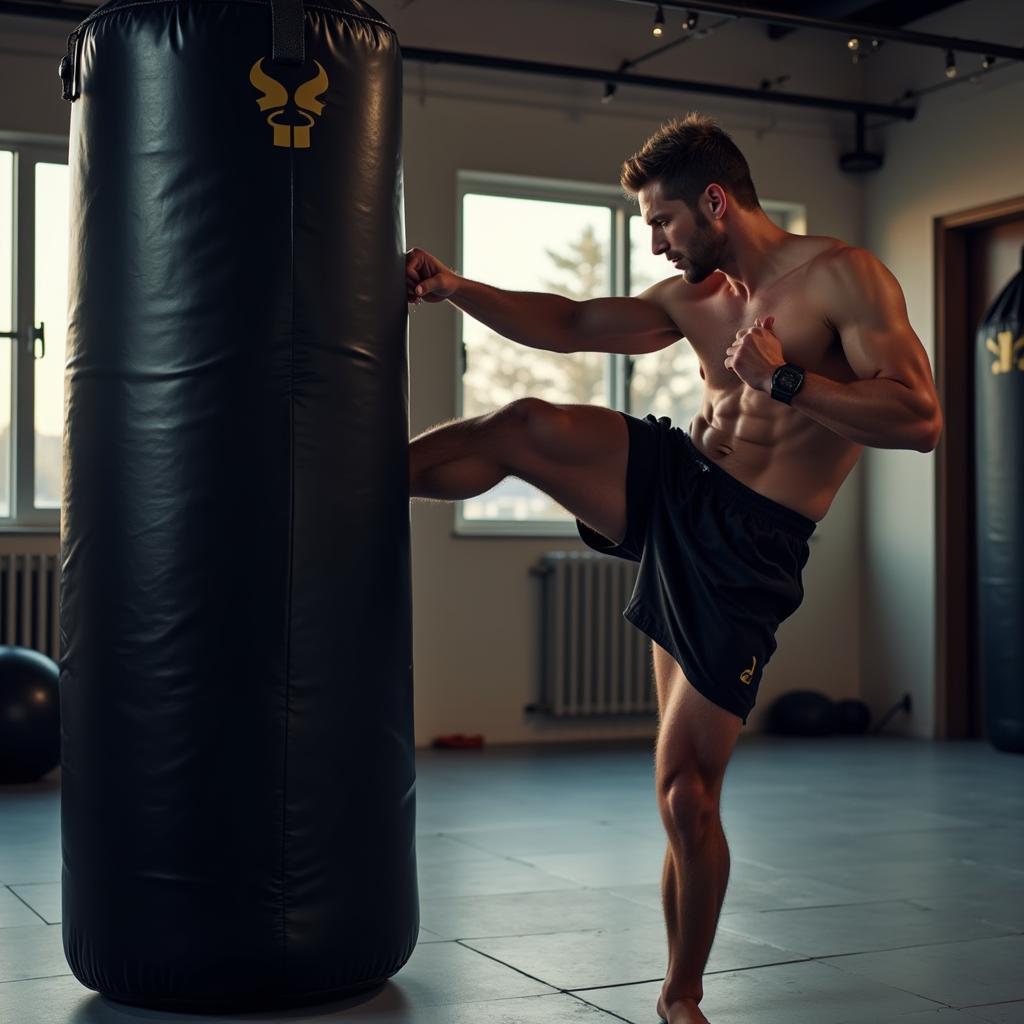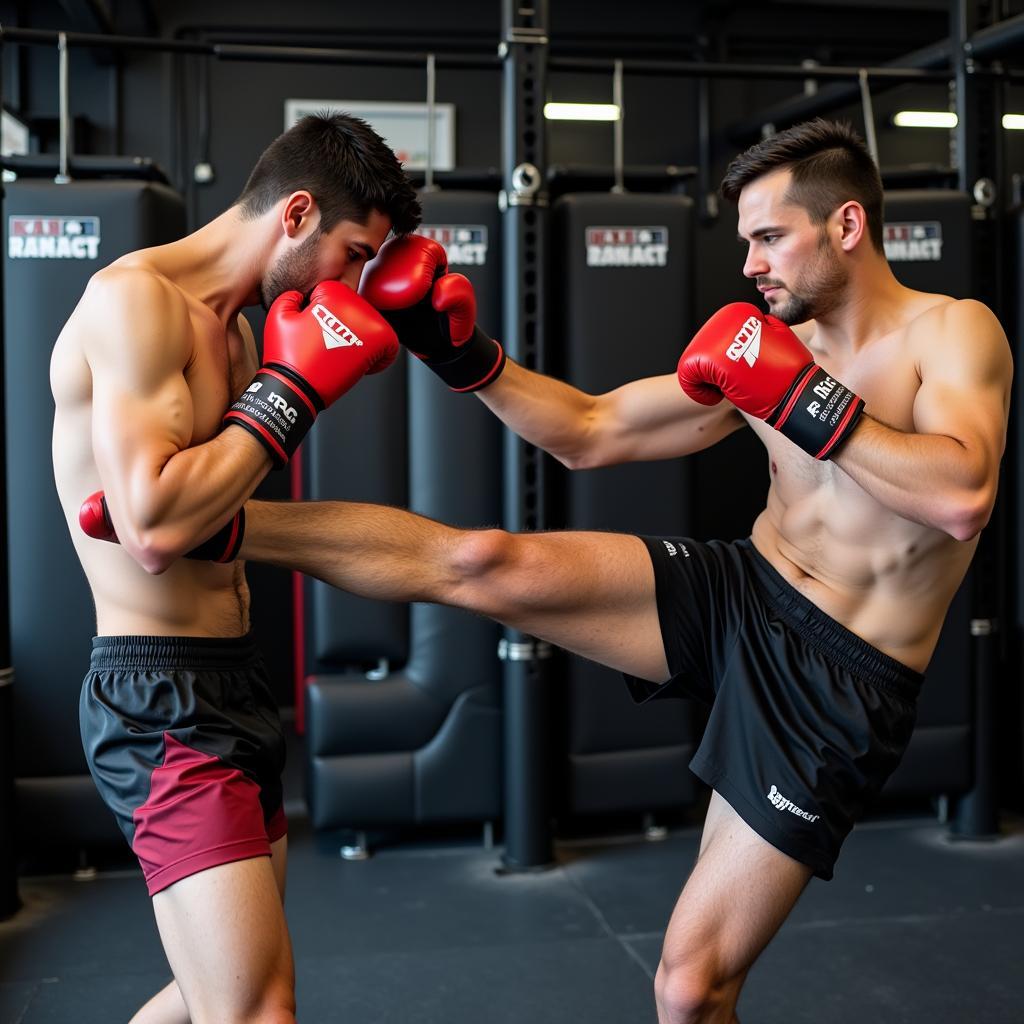Unleashing Power and Precision: A Deep Dive into Martial Arts Kicking Bags
Martial Arts Kicking Bags are more than just inanimate objects; they are silent training partners that help individuals hone their skills, build strength, and develop unwavering focus. Whether you’re a seasoned martial artist or just starting your journey, a good kicking bag can be an invaluable tool. This comprehensive guide will delve into the world of martial arts kicking bags, exploring their types, benefits, and key factors to consider before making a purchase.
The Allure of Martial Arts Kicking Bags: Why They Matter
 Martial arts practitioner training with a kicking bag
Martial arts practitioner training with a kicking bag
Martial arts kicking bags provide a controlled environment to practice and perfect various kicking techniques. They offer consistent resistance, allowing practitioners to work on their power, speed, and accuracy without the risk of injuring a sparring partner. This focused training contributes to improved muscle memory, ensuring that kicks become instinctive reactions over time.
Exploring the Variety: Types of Martial Arts Kicking Bags
The market offers a diverse range of kicking bags, each catering to specific training needs and preferences:
1. Heavy Bags: The Cornerstone of Striking
 Heavy bag training in a boxing gym
Heavy bag training in a boxing gym
As the name suggests, heavy bags are designed for powerful strikes. They are typically filled with dense materials like sand or fabric scraps, providing significant resistance to build strength and power. Heavy bags are excellent for practicing punches, kicks, elbows, and knees, making them versatile training tools for various martial arts disciplines.
2. Freestanding Bags: Mobility and Convenience
Freestanding bags, as the name suggests, stand independently without the need for ceiling mounts or chains. Their weighted base provides stability, allowing for dynamic movement and multi-directional kicking practice. These bags are ideal for home setups or spaces where hanging a heavy bag isn’t feasible.
3. Banana Bags: Targeting Speed and Precision
Banana bags are long, cylindrical bags, often filled with a lighter material than heavy bags. Their shape and size make them ideal for practicing specific kicks like knees, round kicks, and teep kicks. The lighter weight allows for faster strikes, focusing on technique refinement and speed drills.
4. Wall-Mounted Bags: Space-Saving Solutions
Wall-mounted bags offer a space-saving alternative to freestanding or hanging bags. They are securely mounted to a wall stud, providing a stable striking surface without occupying floor space. These bags are suitable for practicing targeted strikes and developing accuracy.
Factors to Consider When Choosing Your Kicking Bag
Choosing the right martial arts kicking bag is crucial to maximize your training and achieve your desired results. Here are key factors to consider:
1. Skill Level: Matching the Bag to Your Expertise
Beginners might benefit from lighter bags that allow for technique development without risking injury. More experienced practitioners can opt for heavier bags or specialized bags that challenge their existing skills and push their boundaries.
2. Training Goals: Defining Your Objectives
Are you aiming for power, speed, or accuracy? Understanding your training goals helps determine the type of bag that aligns with your aspirations.
3. Filling Material: Impacting Resistance and Feel
The filling material significantly impacts the bag’s resistance and feel. Denser materials offer more resistance, while lighter materials provide a softer feel, suitable for speed drills.
4. Size and Weight: Finding the Right Fit
The bag’s size and weight should correspond to your height and weight. A bag that’s too heavy or large can lead to injuries, while a bag that’s too light might not provide sufficient resistance.
5. Material and Durability: Investing in Quality
Martial arts kicking bags endure significant impact, so investing in a durable bag made from high-quality materials is essential for longevity.
Unlocking the Benefits: What Martial Arts Kicking Bags Offer
 Kickboxer practicing kicks with a training partner holding a kicking pad
Kickboxer practicing kicks with a training partner holding a kicking pad
Using martial arts kicking bags offers numerous physical and mental benefits:
1. Enhanced Cardiovascular Health: A Full-Body Workout
Kicking and striking the bag elevates your heart rate, providing a fantastic cardiovascular workout.
2. Improved Muscle Strength and Power: Building Striking Force
The resistance provided by the bag helps develop muscle strength, particularly in the legs, core, and upper body.
3. Increased Flexibility and Range of Motion: Enhancing Mobility
Regular kicking practice improves flexibility and range of motion, enhancing your overall mobility.
4. Stress Relief and Mental Focus: Channeling Energy Positively
The physical exertion involved in kicking bag training acts as a natural stress reliever. Moreover, focusing on your technique and striking with precision cultivates mental clarity and focus.
Conclusion: Embrace the Power Within
Martial arts kicking bags are more than just training equipment; they are tools that empower individuals to push their limits, build confidence, and achieve their fitness goals. Whether you’re a seasoned martial artist or a fitness enthusiast seeking a challenging workout, incorporating a kicking bag into your training regimen can unlock a world of benefits. Remember to choose a bag that aligns with your skill level, training goals, and personal preferences to embark on a journey of self-improvement and martial arts excellence.
FAQs: Frequently Asked Questions About Martial Arts Kicking Bags
1. What is the best filling for a martial arts kicking bag?
The best filling depends on your training needs. Denser materials like sand or fabric scraps offer more resistance, while lighter materials like foam or rags provide a softer feel for speed drills.
2. How heavy should my kicking bag be?
The ideal weight depends on your height, weight, and experience level. A good rule of thumb is to choose a bag that’s roughly half your body weight.
3. Can I use a martial arts kicking bag for other workouts?
Absolutely! Kicking bags can be incorporated into various workouts, including HIIT, cardio, and strength training.
4. How do I care for my kicking bag?
Clean the bag regularly with a damp cloth and mild detergent. Inspect the bag for any wear and tear and address any issues promptly.
5. Where can I buy a high-quality martial arts kicking bag?
You can find reputable martial arts supply stores online or visit local sporting goods stores that specialize in martial arts equipment.
Need further assistance?
Contact us at Phone Number: +84 24 6257 3573, Email: [email protected] Or visit us at Savico Megamall, 7-9 Đ. Nguyễn Văn Linh, Gia Thụy, Long Biên, Hà Nội 10000, Việt Nam. Our customer service team is available 24/7. Explore our website for more articles on martial arts equipment and training tips!



